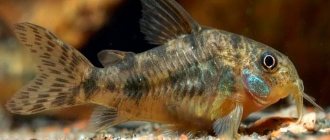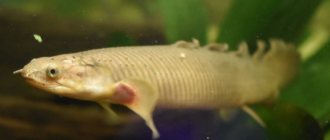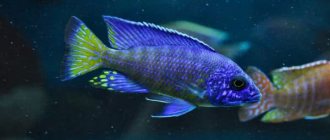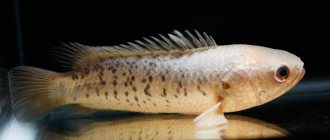03/15/2019Pisces0
Being one of the spectacular representatives of the cichlid family (cichlidae), due to its unusual variegated color, Pseudotropheus Elongatus Mpanga will be an excellent candidate for settling in an exotic-style aquarium.
- 1 Appearance, lifestyle and habitat
- 2 Varieties of elongatus or pseudotropheus
- 3 Mr. Tail recommends: features of maintenance and care
- 4 Feeding
- 5 Compatibility
- 6 Breeding
- 7 Diseases and prevention
Appearance, lifestyle and habitat
The natural habitat of Pseudotropheus elongatus mpanga is only the rocky underwater crevices of Lake Malawi in East Africa.
The appearance of the fish is characterized by an elongated and laterally flattened body. Round head shape. Round eyes, expressive lips. Males are not only larger than females (up to 14 cm and 10 cm, respectively), but they also differ in that there is a fat pad in the upper part of their body, and their colors are more variegated.
Photo gallery of Elongatus Mpanga:
The color is unique: on a bright blue-violet background there are several vertical stripes of black. There are blue lines on the head. The ventral fin of the Mpanga is large and dark in color, with a blue border on top and bottom. The dorsal is motley, like the body itself, and runs along almost the entire spine. Its back part widens and, like the caudal fin, is often colored orange or yellow.
For habitat, priority is given to the lower and middle layers of the water column with tight shelters.
Mpangi are omnivorous, aggressive territory owners. They form small groups led by a single polygamous male.
Interesting Facts
- If you keep different species of Malawian cichlids in the same aquarium, they will interbreed with each other.
- Only those fry that live in good conditions acquire beautiful full coloration. Weak individuals that are constantly beaten by other fish are poorly painted. They have a more faded color of scales and inexpressive stripes.
- The breed of fish is determined by the intensity of color on the caudal fin. A bright blue body with blue-black stripes and an orange tail is considered ideal.
- Pseudotropheus elongatus is popularly nicknamed the “underwater barber” for its love of shortening the fins of others. He suddenly rushes towards the victim and quickly bites off a piece of fin, so that the poor fish does not even have time to react. Veiled species with luxurious fins suffer the most.
Varieties of elongatus or pseudotropheus
According to FishBase, in addition to Elongatus Mpanga, the following varieties of pseudotropheus are distinguished:
- Zebra;
- Demassoni;
- Elongatus – slender;
- Pindani;
- Flavus;
- Williams;
- Galanos;
- Brown;
- Chameleon Cichlid;
- Ater;
- Blue;
- Cyaneus (Spot Blue);
- Bluish-striped (Fuscus);
- Yellowfin (Aki or Atsey);
- Chisumulu (Purpuratus);
- Saulosi;
- Fainsilber.
How to keep pseudotropheus
Keeping exotic fish requires quite a lot of effort from the aquarist , but the appearance of the aquarium makes up for all possible inconveniences.
Arrangement of the aquarium
You need a large aquarium, at least 200 liters. In addition, you will need good technical equipment of the reservoir:
- powerful filtration system, better external;
- aeration system;
- thermostat;
- backlight
The water temperature is maintained at a constant level and does not drop below +22 °C . Weekly water changes up to 20% of the aquarium volume are required.
Water parameters
Temperature ranges from +24 to +28 °C. Hardness - 4–20 units, pH 7.2–8.5.
Maintenance and care
Fish require fresh, well-aerated water , so weekly water changes are carried out at least 20% of the volume of the reservoir.
It is better to lay the soil with pebbles - it is easier to clean it with a siphon. This procedure must be carried out at least once a month.
Mr. Tail recommends: features of maintenance and care
When creating optimal living conditions for Mpanga, the following nuances should be taken into account:
- The recommended minimum aquarium size is 120 liters, with a length of 70 cm for 4 individuals.
- For comfortable conditions, you need a sufficient number of secluded places (a clutter of decor, hard-leaved plants with powerful rhizomes), as well as an abundant amount of stones.
- Substrate – sand. Regular siphon cleaning every week.
- Water indicators: temperature +24…+28 °C; 7.5-8.5 pH; hardness – dGH 10-19°, sufficient level of aeration (medium compressor). Weekly replacement of part of the fluid - no less than a third of the current volume.
Content
Pseudotropheus cannot be considered an easy fish to keep. It is recommended that they be owned by experienced aquarists with extensive experience.
What kind of water is needed?
To get closer to the natural conditions for keeping fish, the water must have the following characteristics:
- the water temperature should be from 25 to 29 degrees;
- hardness - from 3 to 19;
- reaction - from 7.3 to 8.4.
Reference! For water hardness indicators, the tolerance range is the widest: from 4 to 20 units.
What plants do you prefer and how many should there be?
Vegetation for keeping pseudotropheus in the aquarium should be a lot and preferably dense. It is necessary to choose large bushes with wide leaves. Tall algae will create the necessary shade for these fish.
Help: You need to choose plants with developed roots so that cichlids cannot pick them out of the ground.
Lighting
In their natural habitat, these fish live at great depths, so the aquarium should have dim lighting. Light in the container is only needed for plant growth.
Breeding
Elongatus becomes sexually mature when it reaches the age of 1 year.
A properly designed tank with a volume of approximately 100 liters is suitable for propagation: a sufficient number of secluded places and the obligatory presence of large flat stones. The acidity of the water is about 8.3 pH. To ensure a purebred breed, the presence of other varieties is excluded. The population is formed at the rate of: for 1 male – 3-6 females. Provide abundant varied feeding. The male prepares a suitable spawning site and attracts females for mating. After fertilization, females place the eggs in their mouths, where they keep them for the entire period (2-4 weeks). Afterwards, the fry form flocks and stay near the uterus. The diet of young animals includes live dust.
Compatibility
When adding neighbors, you need to take into account that these cichlids have an aggressive nature. Therefore, pseudotropheus compatibility is not the easiest task. Males are especially hostile. They fiercely defend their territory from everyone and can attack their relatives. Some subspecies are not so aggressive. However, in general, experts recommend placing about four females with one male.
Neighborhood is possible only with other representatives of Lake Malawi, similar in size. Small, even predatory fish, will eventually become food. Pseudotropheus coexists with labidochromis, melanochromis, and labeotropheus. It is possible to replant labeo, barbs, astronotus, and some catfish. Under no circumstances should you add angelfish, discus fish, koi carps, goldfish, corydoras, swordtails, etc.
Diseases and prevention
Elongatus is slightly susceptible to disease, but due to its aggressive behavior it often gets injured, which is why it needs special care. The affected fish is placed in a separate container, providing good aeration and, to reduce stress, a secluded place made of stones or decor. In terms of medications, methylene blue is used, coloring the water to a light blue color, and table salt (2-3 g per liter). In case of minor damage, the treatment can be carried out in a common tank, but only use half the recommended dose.
For the treatment of intestinal disorders, Metronidazole is recommended, for a bacterial infection - Biseptol with Cifran at a rate of 5-10 mg per liter of water.
For ichthyophthyriasis, use malachite green dye and increase the water temperature by 5 °C.
Proper care, a cozy environment and a balanced diet can ensure comfortable living of Elongatus in an artificial reservoir for up to 8 years.
Description of the species
Pseudotropheus belongs to the Cichlid family , Mbuna (literally "rock-dwelling") group. They actually live in the coastal rocky area, where they get their food by scraping algae from the surface of the stones.
The color of these cichlids is very diverse, the body size is average, ranging from 9 to 12 cm. Pseudotropheus is distinguished by moderate aggressiveness and high life expectancy - the fish can live about 10 years in an aquarium.
External characteristics
The fish has an elongated oval dense body covered with small scales. All fins are well designed: a powerful symmetrical tail, a long dorsal fin, large pectoral and anal fins. The elongated muzzle ends in a large mouth with plump lips. The mouth opens so well that small fish can easily fit into it. Pseudotropheus has a flexible spine, which allows it not only to swim in a straight line, but also to bend around rocks, moving nimbly and quickly. Huge round black eyes with a rim notice any prey. Pseudotropheus is a toothy predator that demonstrates high intelligence and aggression in the aquarium. Life expectancy in captivity is 8-10 years. How long these fish live depends on the conditions that the owner of the aquarium created for them.
Feeding
The basis of nutrition for Malawian cichlids is plant food in the form of specialized dry mixtures to maintain color and immunity. You can add live food - fresh and frozen: bloodworms, coretra, pollock fillet. Large representatives are pampered once a week with small fish, which cichlids happily catch, showing their hunting instincts. You should not overuse live food: Mbuna tend to refuse plant foods and eat only protein foods, which leads to obesity and early death. The aquarist’s task is to strictly monitor the balance of nutrients supplied with food.
How to feed elongatus?
In nature, the feeding method of pseudotropheus is very unusual. Scraping off special growths from underwater rocks, they position themselves at an angle of 15-45o to them and do not stick to the stones, but slowly suck out everything that gets into their mouth area. More often these are algae or silica from thickets of such algae.
The difference between feeding in an aquarium is as follows: it is necessary to combine 60% plant food and 40% live food in the diet.
Elongatus tastes of daphnia, cyclops, coretra, tubifex and bloodworm.
The plant component can be represented by scalded lettuce leaves, crushed dandelion stems or nettles.
Do not forget that food residues in water can quickly rot and spoil the impeccable quality of the habitat. Therefore, immediately after 20-25 minutes of feeding, they should be carefully collected with a special net.











